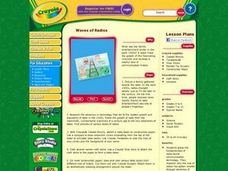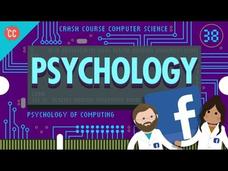Integrated Circuit Teacher Resources
Find Integrated Circuit lesson plans and worksheets
Showing 125 resources
Crash Course
Integrated Circuits and Moore's Law: Crash Course Computer Science #17
See how computers overcame the "tyranny of numbers." Scholars watch the 17th video in a series to learn how integrated circuits replaced large numbers of discrete transistors, paving the way for smaller and less costly computers. The...
Curated OER
Performance-based Assessment for Analog Integrated Circuit Competencies
For this electronics worksheet, students build a circuit based on schematic diagram and answer 33 problems about it. They make prediction before testing and compare it with the actual value.
Curated OER
Passive Integrator and Differentiator Circuits
In this circuits learning exercise, students answer 25 questions about passive integrator circuits and passive differentiator circuits given schematics showing voltage. Students use calculus to solve the problems.
Curated OER
Examining a Microchip
For this computer technology lesson students investigate silicon microchips. Students explore microchip technology using a microscope. Lesson contains hands on investigations.
Curated OER
IC fabrication and packaging
In this fabication worksheet students examine what the acronym "DIP" means. They answer a set of questions and identify integrated circuits.
Curated OER
Design Project: Signal Generator
In this physics worksheet, students design and build a signal generator. They write a lab report and answer 4 short answer questions about their design.
National Nanotechnology Infrastructure Network
Hiding Behind the Mask
Microchips are a man-made wonder. Investigate the manufacturing wonder with a hands-on inquiry-based lesson. Scholars simulate the process of pattern transfer using photoresist. Their conclusion identifies how their process replicates...
Curated OER
Waves of Radios
Students grasp the fundamentals of radio/sound communication technology. They research why the size of radios has gotten smaller through advances of technology...from large radio tubes through transistors through microchips. Students...
University of California
How Dust Is Holding Science Back
There are millions of dust particles in every breath of air. These tiny particles have a huge impact on nanotechnology, microchips, and other types of scientific research. The video highlights these concerns and how they are working to...
Curated OER
Transistor Hunt
Pupils locate transistor devices in school. They explain the importance of transistors.
Curated OER
Many Paths
Students explore the composition and practical application of parallel circuitry, compared to series circuitry. They design and build parallel circuits and investigate their characteristics, and apply Ohm's law. They recognize that...
Curated OER
DC Branch Current Analysis
Engage your class in physics with this series of questions. The first question is the most hands-on and asks learners to build their own circuit. The rest of the questions are related to current analysis. Class members solve 7 problems...
Crash Course
Cybersecurity: Crash Course Computer Science #31
The three most important words for cybersecurity? Secrecy, integrity, and availability. The 31st installment of an informative video series describes cybersecurity measures in the digital age. It explains the three different goals of...
Crash Course
The Personal Computer Revolution: Crash Course Computer Science #25
Mac or PC? An informative video in the Crash Course Computer Science series describes the history of the personal computer, beginning with the Altair 8800. It compares the business models of Apple (closed architecture) and IBM (open...
Crash Course
Boolean Logic and Logic Gates: Crash Course Computer Science #3
Boolean logic just makes sense. A video teaches individuals about Boolean logic and its connection to the binary system. It shows how the operations NOT, AND, OR, and XOR are shown on electric circuits using transistors.
Crash Course
How Computers Calculate—the ALU: Crash Course Computer Science # 5
ALU, what are you? Young computer scientists watch a video to learn about the Arithmetic and Logic Unit (ALU) in the fifth video of the series. They use logic gates to represent each component of this unit.
Crash Course
Software Engineering: Crash Course Computer Science #16
Did you know that Microsoft Office has more than 40 million lines of code? The 16th installment of the Crash Course Computer Science playlist explains how object-oriented programming lets different groups of computer programmers work on...
Crash Course
Hackers and Cyber Attacks: Crash Course Computer Science #32
How can criminals get access to your personal information? Scholars learn how hackers penetrate computer systems. They watch a video that explains phishing, pretexting, Trojan horses, malware, Ransomware, buffer overflow, code injection,...
Crash Course
Computer Vision: Crash Course Computer Science #35
Can your computer recognize you? Scholars learn about computer vision, starting with analyzing digital images. It progresses to face recognition and biometrics and ends with autonomous driving.
Crash Course
Psychology of Computing: Crash Course Computer Science #38
Computers sometimes need to use psychology to improve. The 38th installment of the Crash Course Computer Science playlist looks at how social, behavior, and cognitive psychology play a role in the development of computers and computer...
Crash Course
Robots: Crash Course Computer Science #37
Without computer science, robots would just be scrap metal. Individuals watch an informative video to learn about robots. The video covers a brief history of robots and identifies current advances in robotics. This is the 37th video in...
Crash Course
Educational Technology: Crash Course Computer Science #39
Every minute, users upload 400 hours of video to YouTube, which is how the resource became available. From MOOCs to AI driven intelligent tutoring systems, an engaging video explains how technology has changed the world of education. It...
Crash Course
The Singularity, Skynet, and the Future of Computing: Crash Course Computer Science #40
Are you ready for The Singularity? The last installment of a computer science playlist examines the future of computing. The video looks at the startling rate of advances in computing, sometimes referred to as the...
National Nanotechnology Infrastructure Network
Lines on Paper - Laser Box
See what you cannot see by getting a little creative. An intriguing lesson has learners use lasers to explore X-ray diffraction. Given a box with unknown structures, they shine a laser through the box and interpret the results....

























